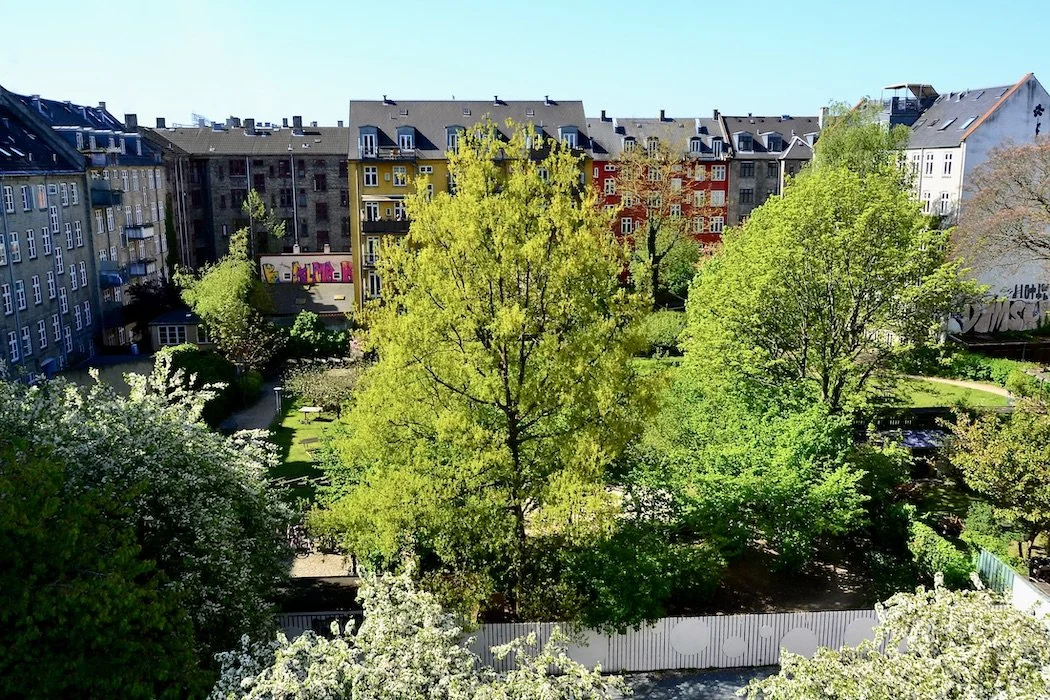Bridging to neighboring cool Nørrebro
View over the lake to the Nørrebro neighborhood
“No one is rich enough to do without a neighbor” – Danish Proverb
On the outer side of the Copenhagen Lakes lies the cool district of Nørrebro, which means northern bridge. Now one of Copenhagen’s most multicultural neighborhoods, Nørrebro was rapidly transformed from countryside into a working-class neighborhood by a building boom that began in 1852. Within 30 years, apartments of various sizes sprang up to house the thousands of farmhands and milkmaids who flocked to the capital seeking factory work during the Industrial Revolution. The workers and their families had running water but were left initially without electricity or indoor bathrooms. For decades afterward, it was a place considered dangerous and best avoided. Though its renaissance began in the 1990s, most visitors have yet to discover it. Yet, this neighborhood with a colorful past is a neighbor that the rich inner city can’t do without.
Queen Louise’s Bridge, leading to the main thoroughfare of Nørrebro, is a stone structure complete with beautiful lamps and four tall flagpoles, where the Dannebrog (Danish flag) is hoisted for the many Danish flag days. Built in 1885, it replaced an older wooden bridge that could no longer handle the increasing traffic into town after the city walls were dismantled. In 2011, the city eliminated car lanes, widened the bike paths and sidewalks, and added benches. A new phenomenon, popularly called “bridging”, quickly flourished, attracting residents on any sunny day, who bring beverages and boomboxes to sit and watch the world go by.
Nørrebro boasts many squares. Two of the most popular squares each have its distinct flavor. Blågårds Plads (Blue Farm Square) takes its name from the blue country estate that stood here in the mid-1600s. By 1827, the estate was gone, and a foundry was built, which made the neighborhood growing around it a very unhealthy place to live and one of Copenhagen’s poorest areas. Now Blågårds Plads is a quiet, attractive gathering place for locals to meet at a bench or café to watch their children play football in summer and skate on the rink in winter.
Sankt Hans Torv (St. John’s Square) was originally common cattle-grazing land along the oldest path that connected the northern and eastern roads leading out of town. Named after the 1862 Saint John’s Church, the square emerged as roads were stone-paved and the neighborhood grew. When café society began to spread from the inner city, the area gradually shed its downtrodden reputation and attracted students and bohemian residents. Decrepit factories were torn down to create green inner courtyards or were converted to theaters, micro-breweries, and shared workspaces. Ground-floor apartments are now chic independent shops, takeaway eateries, or coffee bars.
The most well-loved of Nørrebro’s numerous parks is the Assistens cemetery, which had its start in 1711 to “assist” with the overcrowding of cemeteries within the city walls following numerous waves of plague. Originally swampy ground where tobacco was grown, it was far out of town, so no one wanted to be buried there. Seventy-five years later, preferences changed after an admiral chose to be buried at Assistens cemetery. Still, the cemetery generated many spooky stories and even provided the setting for a Danish detective novel series. Now, it is a place to linger in a park-like setting. The most internationally famous Danes resting here include storyteller Hans Christian Andersen, physicist Niels Bohr, and philosopher Søren Kirkegård.
Don't miss:
A stroll through the peaceful Assistens cemetery.
Serendipity:
“Locals” along the way- wandering through Assistens cemetery and finding that some American jazz greats who had settled in Copenhagen found their final resting place there.
Lunch Tip:
Sebastopol on Skt. Hans Torv, the first café-bistro in the neighborhood, for excellent French bistro food.
Bedtime:
Hotel Kong Arthur, located one block from Queen Louise´s Bridge, recommended by several tour guests, for its comfy rooms and great breakfast.
Subscribe for inspiration to have my posts drop directly into your inbox. *If you enjoyed what you read, please share this post with like-minded travelers.*
*All photographs are mine, taken with my Nikon D3100 or iPhone 8.*










